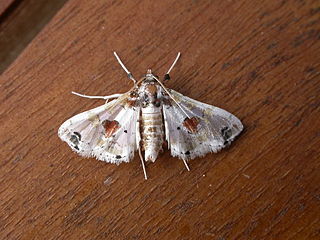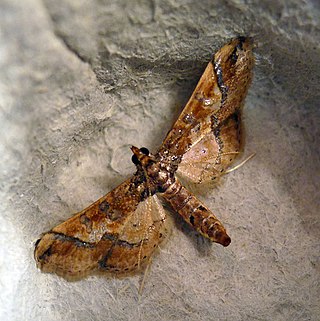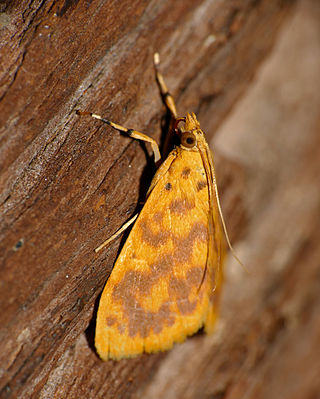
Spilomelinae is a very species-rich subfamily of the lepidopteran family Crambidae, the crambid snout moths. With 4,135 described species in 344 genera worldwide, it is the most speciose group among pyraloids.
Asturodes is a genus of snout moths in the subfamily Spilomelinae of the family Crambidae. The genus is placed in the tribe Margaroniini.
Chrysophyllis is a genus of the grass moth family (Crambidae). It is monotypic, containing the single species Chrysophyllis lucivaga. This moth is very little known, having only been recorded once, before 1935. It belongs to the large grass moth subfamily Spilomelinae; at the time of its description, these were still included in subfamily Pyraustinae and the entire Crambidae was then merged with the snout moths. While its exact relationships are undetermined, it is believed to be a close relative of Talanga. Like these, the male genitalia of C. lucivaga feature a remarkably elongated aedeagus shaped like a bullwhip.

Conogethes is a genus of moths in the subfamily Spilomelinae of the family Crambidae. The currently 17 recognized species are distributed in the Indomalayan and Australasian realm.

Leucinodes is a genus of moths of the family Crambidae. It was first described by Achille Guenée in 1854.

Lineodes is a genus of snout moths of the subfamily Spilomelinae in the family Crambidae. The genus was described by Achille Guenée in 1854, with Lineodes hieroglyphalis as the type species.

Neoleucinodes is a genus of snout moths of the subfamily Spilomelinae in the family Crambidae. The genus was described by Hahn William Capps in 1948 as a Neotropical split-off of the Old World genus Leucinodes.
Loxocorys is a genus of moths of the family Crambidae. The genus was erected by Edward Meyrick in 1894, and has long been considered a synonym of Luma before it was reinstated as genus with the sole species Loxocorys sericea . A phylogenetic analysis showed that Loxocorys is placed in the Spilomelinae tribe Wurthiini, and in genitalia morphology it shares similarities with Niphopyralis.
Sisyracera is a genus of snout moths in the subfamily Spilomelinae of the family Crambidae. It was described in 1890 by Heinrich Benno Möschler with Leucinodes preciosalis as type species, now considered a synonym of Sisyracera subulalis. The genus has been placed in the tribe Udeini.

Terastia is a genus of snout moths in the subfamily Spilomelinae of the family Crambidae. It was described by Achille Guenée in 1854 with Terastia meticulosalis as type species. The genus is currently placed in the tribe Margaroniini, where it is closely related to the genera Agathodes and Liopasia.

Leucinodes laisalis is a species of moth in the family Crambidae.

Hydririni is a tribe of the species-rich subfamily Spilomelinae in the pyraloid moth family Crambidae.

Udeini is a tribe in the species-rich subfamily Spilomelinae in the pyraloid moth family Crambidae. The tribe was erected by Richard Mally, James E. Hayden, Christoph Neinhuis, Bjarte H. Jordal and Matthias Nuss in 2019.

Wurthiini is a tribe of the species-rich subfamily Spilomelinae in the pyraloid moth family Crambidae.

Herpetogrammatini is a tribe of the species-rich subfamily Spilomelinae in the pyraloid moth family Crambidae. The tribe was erected by Richard Mally, James E. Hayden, Christoph Neinhuis, Bjarte H. Jordal and Matthias Nuss in 2019.

Asciodini is a tribe of the species-rich subfamily Spilomelinae in the pyraloid moth family Crambidae. The tribe was erected by Richard Mally, James E. Hayden, Christoph Neinhuis, Bjarte H. Jordal and Matthias Nuss in 2019.

Trichaeini is a tribe of the species-rich subfamily Spilomelinae in the pyraloid moth family Crambidae. The tribe was erected by Richard Mally, James E. Hayden, Christoph Neinhuis, Bjarte H. Jordal and Matthias Nuss in 2019.

Steniini is a tribe of the species-rich subfamily Spilomelinae in the pyraloid moth family Crambidae. The tribe was erected by Achille Guenée in 1854.
Cheverella is a monotypic genus of snout moths in the subfamily Spilomelinae of the family Crambidae. It contains only one species, Cheverella galapagensis, which is endemic to the Galápagos Islands of Ecuador. Both the genus and the species were first described by Bernard Landry in 2011. The genus is placed in the tribe Udeini.

Portentomorphini is a tribe of the subfamily Pyraustinae in the pyraloid moth family Crambidae. The tribe was initially erected by Hans Georg Amsel in 1956.


















